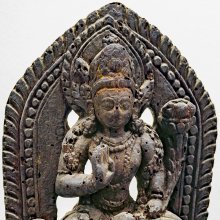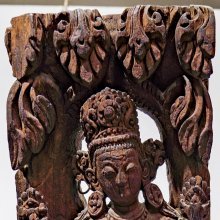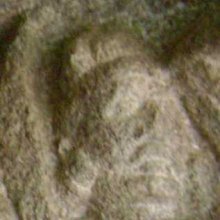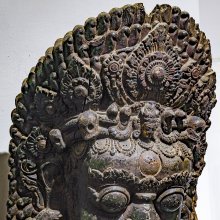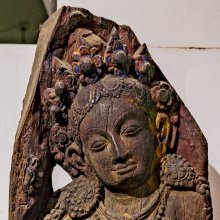Wood: 5 definitions
Introduction:
Wood means something in Buddhism, Pali, Hinduism, Sanskrit. If you want to know the exact meaning, history, etymology or English translation of this term then check out the descriptions on this page. Add your comment or reference to a book if you want to contribute to this summary article.
Images (photo gallery)
(+94 more images available)
In Hinduism
Natyashastra (theatrics and dramaturgy)
Source: Shodhganga: Elements of Art and Architecture in the Trtiyakhanda of the Visnudharmottarapurana (natya)Wood is used as a material for creating artificial masks (of gods, demons, animals, etc.) in Indian Dramas, as part of the Prasta division of Āhāryābhinaya: one of the four divisions of Abhinaya or “ways to convey or represent one’s emotion to others”, according to the Viṣṇudharmottarapurāṇa, an ancient Sanskrit text which (being encyclopedic in nature) deals with a variety of cultural topics such as arts, architecture, music, grammar and astronomy.—The Viṣṇudharmottarapurāṇa says that Prasta denotes the making of artificial masks of gods, demons, demi-gods, different animals and birds etc. by clay, wood, cloth, leather and iron. In the Nāṭyaśāstra, the word pusta is used instead of prasta.

Natyashastra (नाट्यशास्त्र, nāṭyaśāstra) refers to both the ancient Indian tradition (shastra) of performing arts, (natya—theatrics, drama, dance, music), as well as the name of a Sanskrit work dealing with these subjects. It also teaches the rules for composing Dramatic plays (nataka), construction and performance of Theater, and Poetic works (kavya).
Vastushastra (architecture)
Source: Shodhganga: Elements of Art and Architecture in the Trtiyakhanda of the Visnudharmottarapurana (vastu)Wood represents an important Material for the Construction of Temples, which was carefully gathered from the forest, according to the Viṣṇudharmottarapurāṇa, an ancient Sanskrit text which (being encyclopedic in nature) deals with a variety of cultural topics such as arts, architecture, music, grammar and astronomy.—Finding of proper types of materials is one of the important aspects for any construction. In the Viṣṇudharmottarapurāṇa, the architect is suggested to go to the forest to collect appropriate wood for temples in an auspicious day after taking advice from an astrologer. The woods of the trees which are hollow from inside, which bear creepers, which are eaten by worms, slightly burnt by fire, ruined by wind are totally discarded for making temples. [...] After collecting the suitable wood from forest, the architect uses it according to his requirements and purposes.

Vastushastra (वास्तुशास्त्र, vāstuśāstra) refers to the ancient Indian science (shastra) of architecture (vastu), dealing with topics such architecture, sculpture, town-building, fort building and various other constructions. Vastu also deals with the philosophy of the architectural relation with the cosmic universe.
Yoga (school of philosophy)
Source: ORA: Amanaska (king of all yogas): A Critical Edition and Annotated Translation by Jason Birch(A piece of) Wood is denoted by the Sanskrit term Kāṣṭhavat, according to the Amanaska Yoga treatise dealing with meditation, absorption, yogic powers and liberation.—Accordingly, as Īśvara says to Vāmadeva: “[...] [Now], I shall define the nature of that highest, mind-free absorption which arises for those devoted to constant practice. [...] And [that Yogin] is neither alive nor dead, does not see nor close his eyes. He remains lifeless like a piece of wood (kāṣṭhavat) and [thus] is said to be abiding in absorption. [...]”.

Yoga is originally considered a branch of Hindu philosophy (astika), but both ancient and modern Yoga combine the physical, mental and spiritual. Yoga teaches various physical techniques also known as āsanas (postures), used for various purposes (eg., meditation, contemplation, relaxation).
Shilpashastra (iconography)
Source: archive.org: Catalogue of Pancaratra Agama Texts (shilpa)1) Wood refers to one of the materials which can be used for making icons (pratimā), as discussed in chapter 14 of the Vishnu-Samhita: a Sanskrit text written in 2600 verses which covers typical Pancaratra topics through a narrative dialogue between Aupagayana and Siddha Sumati.—Description of the chapter [pratimā-lakṣaṇa]: Icons may be made from gems, metals, stone, colored stones [dhātu], clay, wood—or one may be represented by a painted picture (1-2). Stones for images are to be gathered from certain places only, and should be selected according to specific classifications or desirable qualities (3-27); the ritual procedures for doing this are given (28-46). Similar care should be taken if the icon is to be made of wood, not only in selecting the wood but even down to the details of felling a tree properly (47-60). [...]
2) Wood refers to a material for creating “icons” (pratimā), as discussed in chapter 7 of the Brahma-ratra section of the Sanatkumara-Samhita: an encyclopedic Sanskrit text written in over 3500 verses dealing with a variety of topics such as yoga, temple-building, consecration ceremonies, initiation and dhanurveda (martial arts).—Description of the chapter [pratimā-lakṣaṇa-uddeśa]: Icons may be made of stone, metal, gems, wood or clay. As for stones, these are classified into four groups-named according to the four castes—and it is told which kinds should be used for making proper icons. The discussion includes details about measurements, mistakes to be avoided in fashioning various parts of the icon, what evil effects will come from such defects, etc. (1-75.). [...]

Shilpashastra (शिल्पशास्त्र, śilpaśāstra) represents the ancient Indian science (shastra) of creative arts (shilpa) such as sculpture, iconography and painting. Closely related to Vastushastra (architecture), they often share the same literature.
In Buddhism
Tibetan Buddhism (Vajrayana or tantric Buddhism)
Source: Google Books: The Crystal Mirror of Philosophical SystemsWood refers to one of the “Five Elements” (Tibetan: 'byung ba lnga) in the Chinese tradition (but it is not mentioned in the list of five elements in the Indo-Tibetan Tradition).

Tibetan Buddhism includes schools such as Nyingma, Kadampa, Kagyu and Gelug. Their primary canon of literature is divided in two broad categories: The Kangyur, which consists of Buddha’s words, and the Tengyur, which includes commentaries from various sources. Esotericism and tantra techniques (vajrayāna) are collected indepently.
See also (Relevant definitions)
Starts with (+26): Wood anemone, Wood apple, Wood aster, Wood avens, Wood bluegrass, Wood calamint, Wood cotton tree, Wood flower, Wood garlic, Wood iris, Wood larkspur, Wood lily, Wood meadow grass, Wood of the gods, Wood rose, Wood shaving flower, Wood sorrel, Wood sparrow, Wood strawberry, Wood-nettle.
Query error!
Full-text (+4476): Kashtha, Daru, Candana, Kapittha, Aranyaka, Aguru, Arani, Vanaprastha, Vana, Vipina, Samidh, Khadira, Atavi, Raktacandana, Vaneshaya, Vanya, Vanavasa, Bilva, Vanakammika, Vanecara.
Relevant text
Search found 456 books and stories containing Wood, The woods, Woods; (plurals include: Woods, The woodses, Woodses). You can also click to the full overview containing English textual excerpts. Below are direct links for the most relevant articles:
Yoga Vasistha [English], Volume 1-4 (by Vihari-Lala Mitra)
Chapter CXCVI - Story of a wood-cutter and his gem < [Book VII - Nirvana prakarana part 2 (nirvana prakarana)]
Chapter XX - Remonstration of pavana < [Book V - Upasama khanda (upashama khanda)]
Chapter XXVII - Past lives of lila < [Book III - Utpatti khanda (utpatti khanda)]
Vinaya (3): The Cullavagga (by T. W. Rhys Davids)
Cullavagga, Khandaka 8, Chapter 6 < [Khandaka 8 - Regulations as to the Duties of the Bhikkhus towards one Another]
Cullavagga, Khandaka 5, Chapter 32 < [Khandaka 5 - On the Daily Life of the Bhikkhus]
Cullavagga, Khandaka 6, Chapter 1 < [Khandaka 6 - On Dwellings and Furniture]
Kaka’s Song of the Woods < [October – December, 1986]
The Poet < [October 1947]
The Woods are Still Lovely < [October – December, 2008]
Ramayana of Valmiki (by Hari Prasad Shastri)
Chapter 48 - Angada slays an Asura < [Book 4 - Kishkindha-kanda]
Chapter 25 - Bali’s Funeral Rites < [Book 4 - Kishkindha-kanda]
Chapter 55 - Shri Rama, Sita and Lakshmana cross the Yamuna and travel on < [Book 2 - Ayodhya-kanda]
Mahabharata (English) (by Kisari Mohan Ganguli)
Section XXVII < [Arjunabhigamana Parva]
Section XXV < [Arjunabhigamana Parva]
Section XVI < [Asramavasa Parva]
Rig Veda (translation and commentary) (by H. H. Wilson)
Related products
(+30 more products available)

